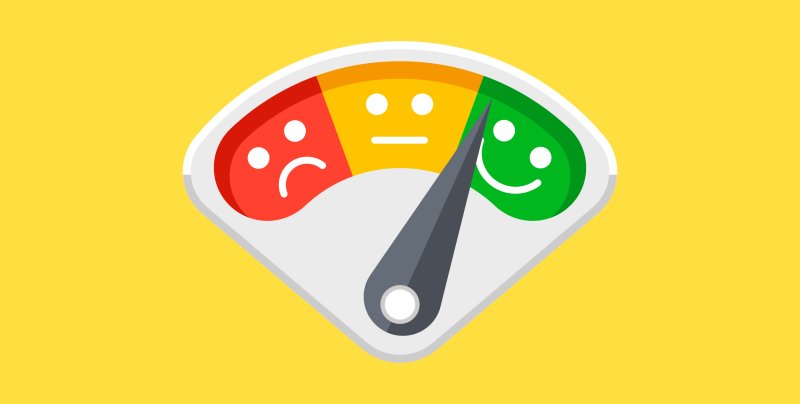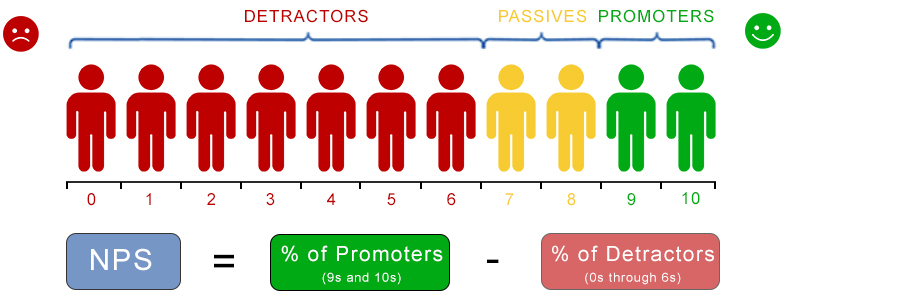
NPS index score
Net Promoter Score is an index/indicator that reflects the level of customer satisfaction with your product/service and their willingness to return to you again or recommend you.
The NPS system gained worldwide recognition more than a decade ago and is successfully used by companies such as Apple, Siemens, Philips, etc.
To complete a customer survey, we can:
- Call them by asking just 2 questions;
- Conduct an online survey using ready-made services (for example: Survey Monkey, or use Google Docs).
The advantages of assessing the level of customer loyalty using the NPS index:
- ease of understanding and managing the metrics;
- the ability to provide two-way feedback;
- clear segmentation of absolutely any company.
Also, conducting such surveys can set you apart from your competitors and become a real competitive advantage.
If your NPS is higher than most of your competitors - it is a sure sign that there is potential to capture the lion's share of the market.
If you have a relatively small customer base, you can easily call everyone in a couple of days.
You only need to ask 2 questions:
1. Please rate from 0 to 10 your willingness to recommend us to your friends.
2. What can we improve, so that next time you give us a 10? (For those who gave a score below 10)
The results of the survey will form 3 groups based on the ratings given to your company:
1-6 points - critics, may spread negative feedback about you. They are often future customers of your competitors.
7-8 points - neutrals. Less often than the first group generate negativity, but there is no guarantee that they will stay with you in the future.
9-10 points - promoters, recommenders. Have a high level of loyalty to you, and often recommend you to acquaintances.

The NPS index is a measure of how much more satisfied you are than dissatisfied you are.
The higher the index, the better the company is doing. The range is from -100 to +100.
If your NPS score is 100, it means that all your customers are brand promoters (the best scenario), and if the score is -100, all your customers are critics (the worst scenario).
Conduct customer surveys regularly (monthly/quarterly, not once or twice a year).
Only this way you can keep your hand on the pulse, get the most objective picture and plan strategic actions aimed at improving the quality of service.
What to do with the results of the NPS evaluation.
Knowing only the level of NPS of the company, you will not always understand whether it is normal or not.
It makes sense to pay attention to the peculiarities of doing business, consumer behavioral factors and the level of competition in different areas of business.
Below is an example of the average NPS level in the context of some industries.
An easy way to see if your NPS is good is to evaluate:
1) whether your index is higher than the market average;
2) whether your NPS is growing over time (from survey to survey).

Now consider what to do with each individual group of customers:
1. Critics.
These are not necessarily clients who can only fall away, and will never become your recommendations. It's quite realistic to get feedback from them in the format of "what exactly they would like to improve," if possible to do so, or to help with their tasks by recommending additional services (if addressing such tasks is not part of your direct expertise).With the right strategy, your critics can become your promoters, and strengthen your market position.
2. Neutrals.
The most interesting segment, they don't like your products but they don't hate them either. These fringe people, who seem to be waiting for something good or bad to happen, that they have decided on their position. You can shake up the neutrals, for example: by offering them bonuses or discounts, or service upgrades, or periodically involving them in the use of new features.
3. Promoters.
The biggest omission of any company is to take the promoter as a given (after all, we all think our product/service is worthy of recognition and appreciation).
Remember: the best thing you can do in the context of increasing the loyalty of your promoters is to thank them for their recognition, verbally or in writing, or by providing some nice distinctive "bonuses". Demonstrate that you really appreciate their feedback and the choices they make in your favor.
Optional: Introduce your promoters to your other products/services. Even if it's not a service these customers can use specifically, they may be eager to recommend you at the first opportunity to their colleagues or acquaintances.
Where else you can apply the NPS:
1. For team management, the eNPS indicator, which measures the level of employee satisfaction (calculated using the same NPS formula), is used.
2. NPS can also become a basic metric for assessing the level of customer satisfaction, sewn into an employee's KPI.
Important:
To increase the quality of NPS customer loyalty results interpretation we recommend to make an additional ABC-XYZ analysis of your customer base (segmentation of customers by payment volume and frequency criteria).
We will tell you more about the ABC-XYZ analysis in the following articles.
____
Author of the article: Valentyna Yurchenko.